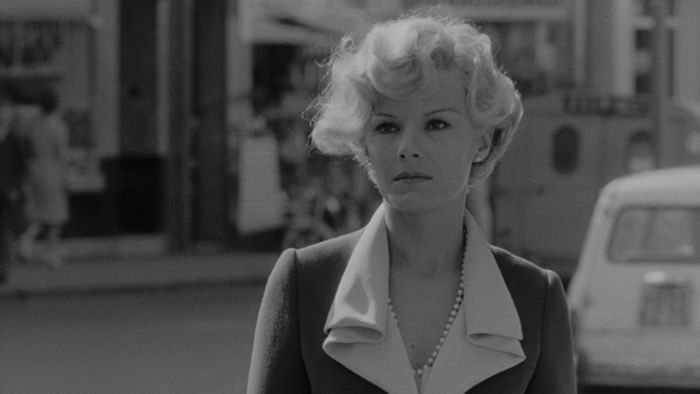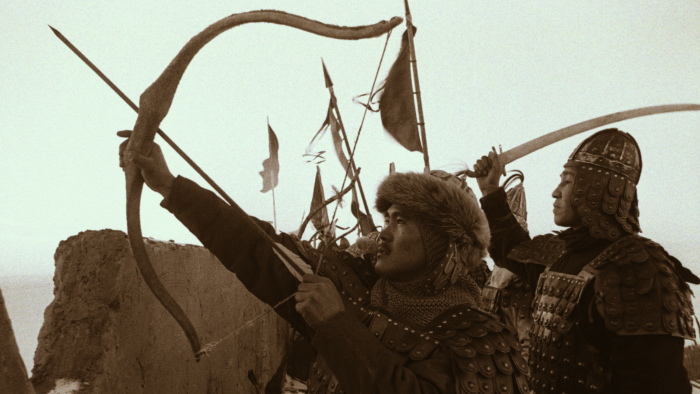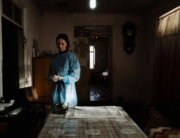Now that the 62nd New York Film Festival has ended, it’s the perfect time to stop and honor an unsung programming section: the rediscoveries that were part of the Revivals sidebar. Among them, three restorations can be highlighted. Hopefully, their run after the festival will encourage exclusive theatrical rereleases and/or online availability.
Let’s follow the chronological order, starting with La Musica (1967), the directorial debut of Marguerite Duras, based on her play and co-directed by Paul Seban. The prolific French writer was one of the most famous intellectual figures of her time, and although her literary work is much more recognized, her ventures into cinema are far from few. Her screenplay for Hiroshima, Mon Amour would have been enough to secure her place in film history, but after nearly 20 films made—often adaptations of her novels and plays—there’s a respectable body of work (including India Song).
Duras approached the audiovisual art form with a blend of curiosity and disdain (and very likely with the self-serving intention of preventing her literary work from being appropriated and adapted by other artists). Coinciding in time and friendship with members of the French New Wave, Duras was both an insider and outsider of the group, so her directorial debut inevitably invited comparisons with her contemporaries. This is more obvious when considering the execution and content of her first film: the black-and-white photography, austere real locations, modern settings, philosophical concerns, and intellectual explorations of relationships between men and women. Plus, the screen presence of actors Delphine Seyrig, Robert Hossein, and Julie Dassin is invasively observed with generous close-ups.
La Musica is not exactly a notable debut, much less when compared to what the New Wave directors achieved that same year (Weekend, La Chinoise, Two or Three Things I Know About Her by Godard, La Collectionneuse by Rohmer, The Young Girls of Rochefort by Demy). Even so, it allows us to observe a renowned artist confronting novelty and inexperience and yielding to the demands of moving images and quickly mastering their seductive tricks. It’s the work of someone quickly learning the effectiveness of what’s written versus what’s shown. Since the play is still performed on stages around the world today, it’s curious how unseen the film adaptation remains. Its simple premise is loaded with passion and intensity: A nameless man (Hossein) and a woman (Seyrig) arrange one last meeting in a hotel that was once a significant place for their relationship. Once husband and wife, they are now divorcing and confronting irreconcilable differences.
Seyrig doesn’t appear on the screen until halfway, but the ghost of her presence and the reminder of the agreed capitulation haunt the character played by Hossein from the start. When the ex-lovers finally meet, they have much to say. Duras’s text combined with the cinematography dissects a relationship, revealing that words might be less honest than looks, gestures, and omissions. La Musica could be considered about divorce. However, it responds to something deeper that recurs in the writer’s work: the dissolution of marriage as a devastating confirmation of love’s mortality.
Made a few decades later, in a completely different era, country, and cinematic movement, The Fall of Otrar (1991) should be a must-see for anyone concerned with world cinema. Likely, this film has never been appreciated in all its visual splendor and narrative scale until this 4K restoration, thanks to the World Cinema Project. It’s an experience that demands total immersion on the big screen and ritualistic silence shared within a theater. Directed by Ardak Amirkulov, it’s a colossal historical epic over two and a half hours long, set in the 13th century, methodically depicting the fall of East Asian empires swept away by Genghis Khan’s brutal conquests.
A peak of the Kazakh New Wave, The Fall of Otrar is a slow-burn tale of political intrigue, explicit depictions of violence and torture, and ambitious battle scenes that aim for an unusual kind of visual grandeur, with a contradictory reverence and repulsion for brutality. Despite its largely sepia-toned cinematography and the exuberance of its production design, this film represents a heavy, difficult viewing experience. Far from the glossy assemblies of Hollywood epics from the same era, like Braveheart (equally violent but reveling in crowd-pleasing spectacle with a moral certainty that never questions itself), the stark realism here at times feels like we’re watching a medieval snuff film or found footage. The raw and cruel historical re-creation evokes a similar effect to what you may experience watching Herzog’s Aguirre, The Wrath of God or Pasolini’s Saló, or the 120 Days of Sodom.
Staring directly at the horrors of war and its consequences, The Fall of Otrar is filled with images that won’t leave your head: ritual sex with perfumes, bodies buried with heads sticking out, and silver masks forged on living flesh as a method of execution. At one point, a protagonist wonders if the Mongols know how to be anything other than soldiers, and the film questions whether there’s any endgame for such overwhelming carnage, all without making an explicit moral denunciation.
Finally, closing out the 20th century, another excellent film awaits rediscovery by a wider audience and to claim its place as an essential classic of American independent cinema. Compensation (1999), the feature debut of Zeinabu irene Davis, solely screened in festivals (Atlanta, Toronto, Sundance), but it never received a proper theatrical release. Critics like Richard Brody (of The New Yorker) have advocated for the artistic and cultural importance of the film as a landmark of Black American art created by a Black female filmmaker. Now, the achievement will be witnessed on a larger scale, with a theatrical release planned for February 2025, followed by its distribution via the Criterion Collection. The director insists on calling this a “rejuvenation,” rather than a restoration, as technological advances have allowed her to enhance the visual and sound quality (it was originally filmed in 16mm) and make crucial improvements to honor and respect deaf audiences (multiple captions fill the screen, not only for dialogue but for every sound and music presented).
Compensation pays homage to the look and modes of silent cinema (intertitles narrating context and actions, sparse camera movement, staged tableaux) without fully surrendering to anachronism—there is spoken dialogue, experimental sound, diegetic music. It tells parallel stories, which in part are the same story set in two different eras: A Black deaf woman (Michelle A. Banks) maintains a romance with a Black hearing man (John Earl Jelks) in the early 20th century (1910) and at the end of it. Both actors play different characters whose stories diverge due to their respective contexts. At the same time, the film exposes how the intersection of sex, gender, race, and disability affect relationships.
In both timelines, an illness (tuberculosis) or condition (HIV) plays a decisive element role. Moments of tenderness (the shy courtship, the attempts to connect despite the barriers of communication) are complicated by obstacles explored in all their complexity: Families or members of the deaf community predict that the relationship is doomed to fail. Banks, who is deaf, has an unforgettable presence and delivers an incredibly moving performance.
Compensation is, and now we can say it is again, a major achievement in execution and an effective melodramatic tale of love and compassion. In its pioneering portrayal of deaf characters, represented in their complicated and conflicted humanity, it is also a necessary missing link for a more insightful understanding of the history of deaf representation on-screen. It closes the gap between Children of a Lesser God (1986) and more recently awarded movies such as Sound of Metal (2020) and CODA (2021).









Leave A Comment